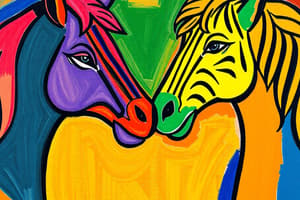Podcast
Questions and Answers
What is learning?
What is learning?
A relatively permanent change in skill or understanding.
What is associative learning?
What is associative learning?
Learning that certain events occur together.
What is classical conditioning?
What is classical conditioning?
A type of learning in which an organism comes to associate events.
Who is Pavlov?
Who is Pavlov?
What is an unconditioned stimulus (US)?
What is an unconditioned stimulus (US)?
What is an unconditioned response (UR)?
What is an unconditioned response (UR)?
What is a conditioned stimulus (CS)?
What is a conditioned stimulus (CS)?
What is a conditioned response (CR)?
What is a conditioned response (CR)?
What is acquisition in classical conditioning?
What is acquisition in classical conditioning?
What is extinction in classical conditioning?
What is extinction in classical conditioning?
What is spontaneous recovery?
What is spontaneous recovery?
What is generalization in classical conditioning?
What is generalization in classical conditioning?
What is discrimination in classical conditioning?
What is discrimination in classical conditioning?
What is the Law of Effect?
What is the Law of Effect?
What is shaping?
What is shaping?
What is chaining?
What is chaining?
What is primary reinforcement?
What is primary reinforcement?
What is secondary reinforcement?
What is secondary reinforcement?
What is positive reinforcement?
What is positive reinforcement?
What is negative reinforcement?
What is negative reinforcement?
What is a continuous schedule of reinforcement?
What is a continuous schedule of reinforcement?
What is a fixed interval schedule?
What is a fixed interval schedule?
What is a fixed ratio schedule?
What is a fixed ratio schedule?
What is a variable ratio schedule?
What is a variable ratio schedule?
What is a variable interval schedule?
What is a variable interval schedule?
What is a token economy?
What is a token economy?
Flashcards are hidden until you start studying
Study Notes
Learning Concepts
- Learning is defined as a relatively permanent change in skill or understanding.
- Associative learning involves linking certain events, which can include stimuli pairings (classical conditioning) or responses with consequences (operant conditioning).
Classical Conditioning
- Classical conditioning is a learning process where an organism associates a neutral stimulus with an unconditioned stimulus (US), leading to a learned response.
- Reflexive and automatic responses are characteristic of classical conditioning.
Key Figures
- Ivan Pavlov, a physiologist known for his work on digestion, discovered the principles of classical conditioning through experiments with dogs.
Stimuli and Responses
- Unconditioned Stimulus (US): A stimulus that automatically elicits a response without prior learning.
- Unconditioned Response (UR): The automatic response produced by the unconditioned stimulus.
- Conditioned Stimulus (CS): A previously neutral stimulus that begins to elicit a conditioned response (CR) after being paired with the US.
- Conditioned Response (CR): A learned response that occurs in reaction to the conditioned stimulus.
Learning Processes
- Acquisition: The process where the conditioned stimulus begins to evoke the conditioned response; this is the foundational stage of leaning in both classical and operant conditioning.
- Extinction: The reduction of a conditioned response when the conditioned stimulus is presented without the unconditioned stimulus, or when a response is no longer reinforced.
- Spontaneous Recovery: The re-emergence of an extinguished conditioned response after a rest period.
Generalization and Discrimination
- Generalization occurs when a similar stimulus to the conditioned stimulus also evokes the conditioned response.
- Discrimination is the ability to distinguish between different stimuli, allowing specific responses to occur only with the conditioned stimulus.
Operant Conditioning Principles
- Law of Effect: Proposed by Thorndike, this principle states that behaviors followed by positive outcomes are more likely to be repeated, while behaviors followed by negative outcomes are less likely to recur.
- Shaping: A technique used to teach new behaviors by reinforcing successive approximations towards a desired behavior.
- Chaining involves linking together a series of behaviors to form a complex behavior sequence.
Reinforcement Types
- Primary Reinforcement: Involves stimuli that do not require learning to appreciate (e.g., food, water).
- Secondary Reinforcement: Involves stimuli that require learning to appreciate (e.g., money, praise).
- Positive Reinforcement: The introduction of a favorable event to increase the likelihood of a behavior being repeated.
- Negative Reinforcement: The removal of an aversive stimulus to increase the future likelihood of a behavior.
Reinforcement Schedules
- Continuous Schedule: Reinforcement is applied every time the behavior occurs.
- Fixed Interval: Reinforcement is provided after a set amount of time has passed.
- Fixed Ratio: Reinforcement is delivered after a specific number of responses.
- Variable Ratio: Reinforcement occurs after an unpredictable number of responses, making it more resistant to extinction.
- Variable Interval: Reinforcement is given after a varying amount of time, resulting in steady responses.
Token Economy
- A behavioral strategy where individuals earn tokens for desired behaviors, which can later be exchanged for various rewards, applying operant conditioning principles.
Studying That Suits You
Use AI to generate personalized quizzes and flashcards to suit your learning preferences.




